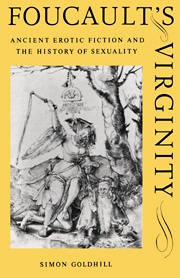3 - HOW LIKE A WOMAN
Published online by Cambridge University Press: 26 January 2010
Summary
What kind of tales did men tell men,
She wondered, by themselves …
TennysonIn the previous chapter, I discussed how we can understand the formal debates on whether it is better for men to desire men or women, what the space for such arguments is within the intellectual world of late Greek writing, and how it relates to the intellectual traditions of classical Greek sophia. In this final chapter, I shall turn to look more specifically at how desire for women is framed by a set of representations of women – a set of representations written, inevitably, almost exclusively by men of a particular class and education. For the discussion of male sexuality is ineluctably linked to a representation of the female, and although for largely heuristic purposes I have separated the discussions of male and female desire, the intertwining of topics is necessary and will be evident throughout what follows. I have called this chapter ‘How like a woman …’ in the hope of evoking an ambiguity between the certainty of exclamation, ‘How like a woman!’, and a more doubtful questioning, ‘How like a woman?’, ‘How? Like a woman?’ It is the space of representation mapped by these expressions that I wish to explore, as I travel towards that central text in the history of desire, Plutarch's Amatorius.
To help focus what is a huge topic, I shall be concentrating on two sets of interlocking questions, first the problem of female chastity and knowledge, and second the problem of how sexual difference – the degree to which men and women are alike – is articulated with regard to chastity.
- Type
- Chapter
- Information
- Foucault's VirginityAncient Erotic Fiction and the History of Sexuality, pp. 112 - 161Publisher: Cambridge University PressPrint publication year: 1995

